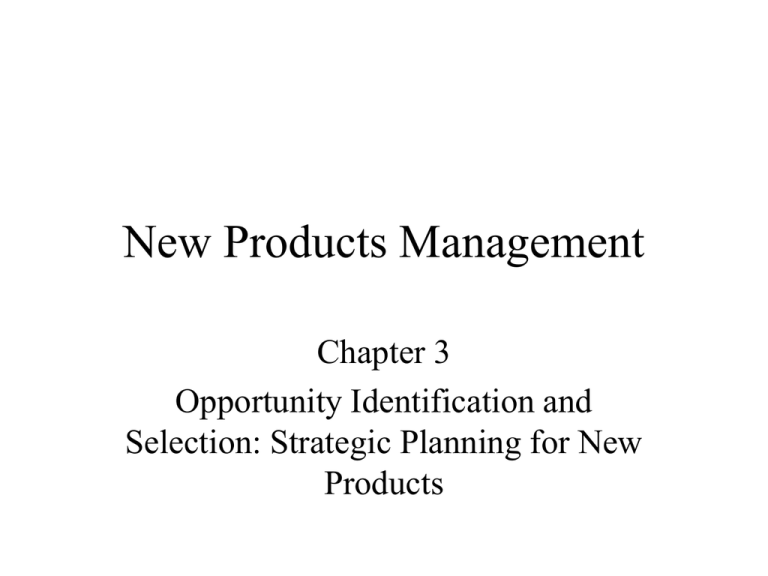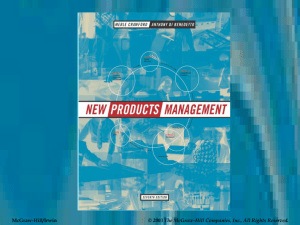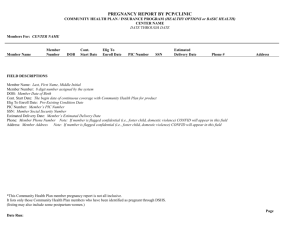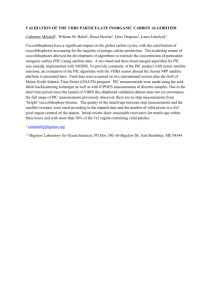New Products Management
advertisement

New Products Management Chapter 3 Opportunity Identification and Selection: Strategic Planning for New Products Why Does a Firm Need a New Products Strategy? • To chart the group’s/team’s direction – What technologies?/what markets? • To set the group’s goals and objectives – Why does it exist? • To tell the group how it will play the game – What are the rules?/constraints? – Any other key information to consider? What is the Product Innovation Charter (PIC)? • It is the new product team’s strategy. • It is for Products (not processes). • It is for Innovation (think of the definition of new product). • It is a Charter (a document specifying the conditions under which a firm will operate). Charters Have a History • Gerber had one for babies. (Note: charter can be for entire firm, or any part of one.) • Land said any project at Polaroid had to “almost impossible.” • Wrigley was in the “gum” business. • Loctite built a business on one adhesive (a technology) that GE didn’t want. • Sony, Honda, Rubbermaid and (for many years) P&G competed through product proliferation. • Braun competed through design. • 3M and Philips simply said they would compete through innovation. Figure 3-1 Contents of a PIC • Background: Key ideas from the situation analysis; management dicta • Focus: A clear technology dimension and a clear market dimension that match and have good potential. • Goals/Objectives: What the project will accomplish. • Guidelines: Rules, requirements, time/quality/cost, etc. Figure 3-1 (cont’d.) A Sample PIC This is a PIC for an intangible business product. • Background/Focus: Smaller offices have bought new computer systems, pose unique service opportunity which we will address using (1) our system analysis skills and (2) our field service capabilities. • Goals/Objectives: (1) To overcome all reasonable objections about service levels by this group, (2) increase net operating revenues from this service by $18 million per year. • Guidelines: Create unique service approaches based on current field service resources; protect from quick competitive emulation; low development expenditures; minimum development time required. A Closer Look at the PIC • Background: Answers the question “why did we develop this strategy?” • Focus: – Technology drivers (laboratory, marketing technology, product specialization) – Market drivers (customer group problems, end use or activity) – Dual-drive firms (putting a technology and market driver together to yield a precise focus) A Closer Look at the PIC • Goals/Objectives: profit, growth, market status, miscellaneous. • Special Guidelines: – Degree of Innovativeness (pioneer, second but better, or imitator?) – Timing (first, early entrant, later entrant) – Miscellaneous (brand equity, patentability) Technology Drivers • Materials -- Corning’s glass. • Processes -- Deloitte & Touche’s financial information analytical capabilities. • People -- A scientist, an engineering group, even a product management group. • Facilities -- Kimberly-Clark’s paper-making lines, White Consolidated’s assembly lines. • Other -- Any strong competency -- e.g., industry knowledge in the beer business. Market Drivers • Customer group or resellers -- ski shops, European importers, Ford Motor Co., etc. • End users -- All skiers, beginning skiers, professional skiers. • End use, activity -- skiing, food manufacturing, etc. • Others -- mass customizing (focusing on everyone individually, such as Courtyard, and Dow Jones Personal Journal), a competitor’s customers, etc. Figure 3-3 The Flow That Produces PICs Corporate Strategy Platform A PIC Project 1 PIC Project 2 PIC Platform B PIC Project 3 PIC Project 4 PIC All other sources of facts, opinions, trends, etc. These are sought in some cases and come in without seeking in others. The option of which, if any, to use is pretty much with the project team. Some are inside (departments) and some outside (customers, competitors, distributors, etc.). They do not have the power of the higher strategies even though they may be platforms (e.g., brand). Tips for PIC Development • Note where you are starting -- what decisions have already been made? • Watch for any and all opportunities. • Confirm interesting opportunities. • Keep balance between focus and freedom -- wildcatting can pay off too. • Speed usually assumed a well-established, close-to-home PIC. • PICs less useful in cases where personal tastes rule (art, games, foods) or where the biggest task is developing a new technology (wait till you have it). More Tips • Poor implementation will still ruin a good PIC (e.g., Bic perfume in lighter fluid package). • Watch for PIC conflicts -- e.g., a “flood the market” line extension strategy may hurt real innovation. Some charters dictate separate organizations. • Once in place, live by it. Use at all stages -- organization, concept generation, concept evaluation, technical, and, yes, marketing! • Change it only when necessary, or when you get information you have been waiting for.





